Here Come the Toy Ads

Updated November 2016
It’s early fall as I write this, and already toy advertisers and marketers have their holiday ad plans in place. Their priority: the placement and positioning of their commercial spots on all of the networks that carry children’s programs.

As Holiday 2016 approaches, parents and educators have another one of those “teachable moments.” Using toy commercials in the classroom is a great way to jump-start media literacy. Media literacy, as I’ve defined it, is about applying critical thinking/viewing skills to media messages. And one of the most powerful media messages is the persuasive television commercial.
When most of us watch television, we’ve turned off the thinking parts of our brains. It’s the job of educators to teach students how to turn on those “thinking parts” while we watch and develop critical thinking skills. And once kids begin to be discerning consumers of media, they can have a lot of fun deconstructing what they see.
Looking behind the scenes
Media literacy is also about understanding the production process, because most of us only see the finished media product — we rarely get to go behind the scenes to witness how a production moves from conception to completion. In my own teaching, I help young people comprehend and appreciate the tools (camera, lights, sound, special effects) and the techniques (camera angles, masculine/feminine colors, soft/loud music) used to make toy ads which appeal to their emotions.
Toy advertisers, like most all other advertisers, know that they must showcase their products in the best possible light. Sometimes that means using tricks and hoping unsuspecting viewers won’t notice. These finely crafted messages are some of the most persuasive and influential ads on television.
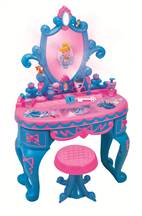
At the conclusion of the ad, I ask my audiences to indicate how tall they think the vanity is, and they all believe it is taller than it actually is. To demonstrate this, I unfurl a poster I had made showing the actual height of the toy — much shorter than anyone had guess-timated. Then I replay the commercial and point out the brief second which reveals that the toy has been placed on a platform. The commercial is deceptive, but many viewers (and most young people) are unaware. They’ve not been taught how to watch with a critical eye and see through the spin. This is where media literacy comes in.
Buy Me That
In 1990, HBO, in a collaboration with Consumer Reports Television, aired the first of three half-hour specials about children and advertising, entitled Buy Me That. The programs helped pull back the curtain on many of the techniques and tricks used in TV commercials. These videos, now unfortunately out of circulation, became favorites with media educators, myself included.
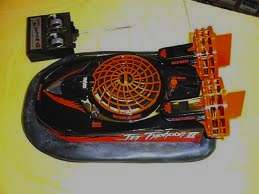
The producers of the Buy Me That documentary decided to field test the toy. They gave an actual Typhoon 2 toy to some kids to test outside. We see them on a basketball court trying to maneuver the toy, but increasingly it does not perform. Next, we see these same children try to launch the toy onto a pool of water, like they saw in the commercial, but alas it sinks. One of the children summarizes the experience and advertising when he says: “we tried it many times, but it failed” and “even though it looks good in the commercial, it’s just not good.”
This segment is eye-opening for the young people who participate in my media literacy workshops. I’ve demonstrated that toy ads (which they’ve believed up till now) cannot be trusted. This is a critical lesson all young people should receive, and not just at holiday time.
 Extending the learning
Extending the learning
Invariably, after seeing this segment, children want to share a time when they received a birthday or holiday toy that also failed to live up to their expectations. This is a perfect opportunity to engage them in a writing activity.
I ask, “Who could you write to, in order to complain about deceptive toy advertising?” They brainstorm. Typical answers include the President of the United States, the toy store, the toy company. It’s rare that anyone suggests complaining to the TV network or station that aired the commercial.
Then I’ll ask, “don’t broadcasters have an obligation to run advertising that is truthful and not deceptive?” A follow-up question asks students to do the research: who in Washington DC is responsible for deceptive advertising? (The Federal Trade Commission) Then we brainstorm about other things young people can do when they encounter deceptive or false advertising. (One idea: write and publish toy reviews on the internet. Another: make substitute ads showing what toys really do.)
Here’s my lesson plan for the Typhoon II, which includes a link to a 3-minute excerpt from Buy Me That, showing the Typhoon II segment.
The Critical Inquiry process
At the heart of media literacy is asking questions — and not just any questions. To become media literate, we have to pursue a line of inquiry that helps reveal who’s behind the message.
Questions to consider include:
- who created the ad?
- for what purpose?
- using which techniques?
- for what audiences?
It’s not rocket-science. But it is important.
It’s up to adults to overcome media illiteracy
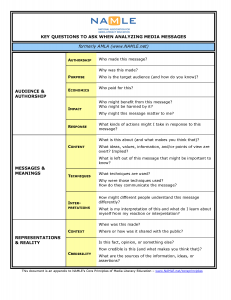
This is where parents and educators come in: it’s our job to use the media, and popular culture, as the hooks to teaching critical thinking (and those all important curriculum standards.)
If you want to know more about media literacy, I suggest you spend some time on the website of The National Association for Media Literacy Education (NAMLE). On their site, you’ll find the Core Principles of Media Literacy. And, above, see NAMLE’s Key Questions students should consider when they encounter any media message.
If you want to know more about toy advertising, surf over to my website page about How Toy Advertising Influences Kids. If everyone reading this would engage young people in media literacy education, we’d all be better because of it.
ALSO SEE: Frank Baker’s 2014 post about holiday toy ads for more lesson ideas.
For further reading:
► What Toy Commercials Are Really Selling by Michele Yulo
► Guys and Dolls: Why Kids’ Advertising is Going Gender Neutral by Sarah Shearman
► The Gendering of Our Kids’ Toys And What We Can Do About It by Elizabeth Sweet
► Teaching Kids to Deconstruct the Advertising Pitch by Wendy Stephens
► 2016 Toy Fair Round-Up by Laurie Schacht, the Toy Insider Mom
__________
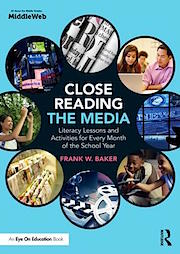

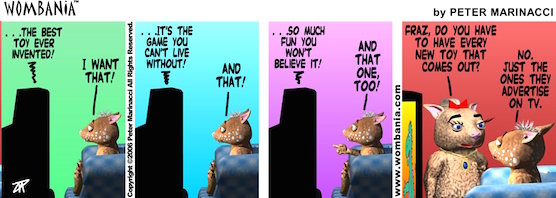






























2 Responses
[…] Toy commercials, so pervasive during the holidays, are a great way to jump-start media literacy discussions with students. Expert Frank Baker has some suggestions. […]
[…] Here Come The Toy Ads […]